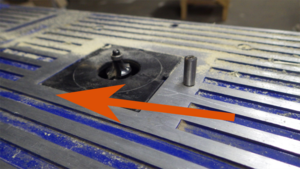Router Table Introduction: Difference between revisions
m (Tutor Patrick (according to Webling)) |
(new router table is an actual table - no need to screw down ;-)) |
||
| Line 14: | Line 14: | ||
** '''only feed from right to left when you work in front of the bit!''' | ** '''only feed from right to left when you work in front of the bit!''' | ||
** see schematic for other cases, but make sure you really '''understand''' what's going on | ** see schematic for other cases, but make sure you really '''understand''' what's going on | ||
* keep all body parts at least a hand's width away from the exposed bit (use [[Push Blocks|push blocks]] if that's not possible) | * keep all body parts at least a hand's width away from the exposed bit (use [[Push Blocks|push blocks]] if that's not possible) | ||
* use all possible fences, guards, [[featherboards]] etc. to secure the workpiece and reduce exposure of the bit | * use all possible fences, guards, [[featherboards]] etc. to secure the workpiece and reduce exposure of the bit | ||
Revision as of 21:27, 28 February 2024
This is the content required for an introduction to our router table - reading this does NOT replace the mandatory session with a tutor! It will make it a lot quicker though ;-)
If you need this introduction, please reach out to the following tutors: Lukas, Martin, Keno, Patrick
The handheld router introduction is required as a background for this introduction!
If you received that introduction before 2020-4-15, it still included the router table part and you only need to make sure you now watch both pages for updates. And as always: feel free to ask for a refresher whenever anything is not clear anymore!
When working on a router table, additional care needs to be taken as the router is turned upside down in a fixed position!
- the workpiece can be grabbed and shot across the room if you attempt a climb cut, only do push cuts!
- only feed from right to left when you work in front of the bit!
- see schematic for other cases, but make sure you really understand what's going on
- keep all body parts at least a hand's width away from the exposed bit (use push blocks if that's not possible)
- use all possible fences, guards, featherboards etc. to secure the workpiece and reduce exposure of the bit
- make use of a starting pin (or similar) when working fenceless with a bearing bit tip #6
Demonstration
The tutor will show you in detail how to:
- Adjust and lock the height of the router
- Insert the bit into the router
- Tighten the collet (best through the top of the table)
- Turn the router on and off by using the safety switch of the router table
- How to properly store the fence together with all small parts so stuff does not get lost all the time!

